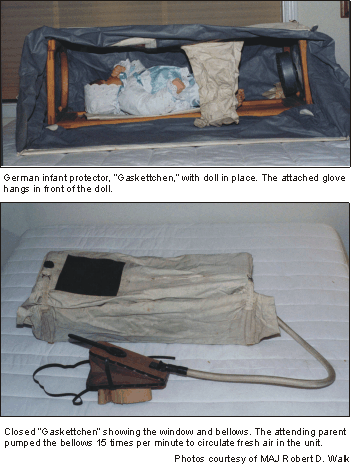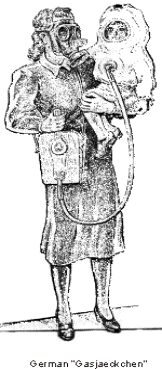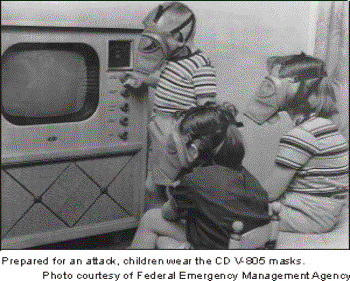|
WE MUST PROTECT By MAJ Robert D. Walk Protection of children during war is a major concern for
government planners of all nations. Children are, after all, the
future of any nation. As a result, the advent of chemical weapons
led to the adoption of several forms of protection for children
and at least a few innovative ideas.
Child protection in World War II consisted of
air-purifying respirators (APRs) and human-powered air-purifying
respirators (PAPR). This article explores protection for infants, young
children, and older children used by the Germans and Americans during
World War II and describes current trends in child protection. Infants Infants represent a challenge to protection efforts.
Their body size and composition change constantly. They grow by leaps
and bounds. Not only are infants small and cute, but they defy all
efforts to get them to follow instructions! One can only imagine trying
to put a respirator on a struggling, colicky 3-month old. Thus, a
protective apparatus had to be built to contain the entire body, not
just the head. However, an infant lacks air intake potential to overcome
a filter’s resistance, so fresh air must be continually provided to
prevent suffocation.
After the attack on Pearl Harbor, the perceived threat
of continued attacks against the Hawaiian Islands was high. Such attacks
could conceivably include chemical weapons. COL Unmacht, chemical
officer for the Department of Hawaii (and the territory of Hawaii), sent
a request for children’s masks to Washington, DC on 18 December 1941,
but none were available. As a result, COL Unmacht, in conjunction with
the Hawaiian Surgeons Office, set about to create infant protection
equipment from resources within the Hawaiian Department. The result of
these efforts was a box respirator and a protective hood for infants.
The box respirator was never produced in quantity. The protective hood
for infants was known as the "Bunny Mask" because COL Unmacht
found that adding "ears" to the hood and wiggling them put a
sense of play into children that could entice them to wear the
protective hood. The mask was locally designed, tested, and produced
using available materials. The mask had an inner and outer bag, an
eyepiece for viewing, and a drawstring. The outer bag was constructed
from felt or denim impregnated with CC-2 (chloramide powder) in
paraffin. The inner bag was muslin impregnated with paraffin. The
eyepiece was scrap celluloid from old x-ray negatives. Inside the hood
was a small breathing pad made of a double layer of heavy Turkish
toweling that was dampened with a 5 percent sodium phenolate solution
prior to use. All seams were double stitched. This was a multifunction mask that served as an infant
protector (entire infant placed into the hood), toddler protector (tied
around the waist), and youth (under 5 years) mask (tied about the neck).
The mask was issued with a small bottle of sodium phenolate and Bulletin
Number 5 (Directions for Use of Bunny Masks), published on May 14, 1942.
This mask, an air-purifying respirator, was produced in quantity within
the Hawaiian Department. The first 3,000 masks were issued in Hawaii in
June 1942, with deliveries completed to the outer islands by December. A
total of 37,643 masks were issued within the territory of Hawaii. To meet the needs of the continental United States,
several designs were examined, including box respirators. Ultimately,
the Office of Civil Defense designed, adopted, and produced the M1
Infant Protector. This is an impermeable, rubber-coated, layered fabric
bag with an acetate viewport for the baby. An external hoop maintains
the shape and the protector is sealed with a drawstring cord. The baby
is inserted into the bottom of the protector and the drawstring is
pulled and tied. The attending parent pumps air using a rubber,
accordion-styled bellows unit through an M1 Training Filter to the
infant. To ensure adequate air for the child, the bellow must be pumped
about 15 times per minute. Like the Gaskettchen, the M1 Infant Protector
is a human PAPR. In comparison to the German cradle protector, the US
Infant Protector is lighter in weight and easier to carry. The US Infant
Protector, M1, was destandardized in 1945. After the war, technology of synthetic materials
advanced quickly. As a result, the M2 Infant Protector (Civil Defense
designation: CDV-815) was made of vinyl and shaped like a GI pup tent.
The protector was meant for children up to 4 years old. The design
allows for the diffusion of air through enclosed filters in sufficient
quantity to provide ample oxygen to the child and eliminate the need for
an air pump. The tent-shaped protector has three large filters on the
two long sides of the protector with one clear viewport covering the
remaining area. An exterior metal frame supports the tent and a shoulder
carrying strap is attached to the frame. The child is inserted into the
protector through an apron on the front; the apron is rolled up and
sealed with snaps onto the frame. The view-port allows Mom and Dad to
see the baby and the baby to look out. Toys can be placed in the
protector to keep the baby occupied. Finally, the protector was designed for mass production
using the latest manufacturing technology. This reduced its cost to
about $25 and theoretically would allow the average American to purchase
one easily. This protector was adopted as standard in 1960 but was not
produced in quantity in the United States. Young Children Young children, ages 2 to 6, also represent a serious
challenge to the defense planner. As with an infant the child is
constantly growing, but is still not able to completely follow
instructions! The child is very energetic and will not sit still long;
thus the protective apparatus should be built to contain the torso. As
with infants, it is best, although not required, to provide air in an
over-pressure mode. Infant protectors could also be used to protect
toddlers and young children, as long as the child fits in the protector.
As with the Gaskettchen, the Gasjaeckchen must be
constantly supplied with air by the parent pumping the bellows. Like the
other German and American World War II efforts, the Gasjaeckchen is a
human PAPR. These protectors were stored throughout Germany in air-raid
shelters. Like the cradle, the Gasjaeckchen was sent to the United
States and evaluated by American scientists. This protector included
such good ideas that scientists recommended a child and infant protector
using it’s best design points (arms, waist tie, and pumped air) be
designed in the United States. One idea acted upon in the United States for protecting
young children during World War II was the Mickey Mouse (©Disney)
mask. On January 7, 1942, one month after the Pearl Harbor attack, the
owner of the Sun Rubber Company, T.W. Smith, Jr. and his designer,
Dietrich Rempel (with approval of Walt Disney), presented the design of
the Mickey Mouse Gas Mask for children to Major General William N.
Porter, Chief of the Chemical Warfare Service (CWS). After approval of
the CWS, Sun Rubber Products Company produced sample masks for review.
This mask, made of injection-molded colored plastic, complete with mouse
ears, looks like Mickey Mouse! They are APRs. The hope was that the
design of the mask was such that children would carry it and wear it as
part of a game. This would reduce the fear associated with wearing the
gas mask and would, hopefully, improve their wear time and, hence,
survivability. A few Mickey Mouse masks were manufactured, but studies
showed the key to keeping children in masks was adult interaction, not
mask design. Another World War II mask, the M2-2-1 Small Child’s
mask, was developed from the M1-series Noncombatant Gas Mask. The M2
Noncombatant Gas Mask, Small Child, was issued with the M2 Noncombatant
Canister and the M1 Noncombatant Carrier, M2-2-1. The mask was an
adaptation of the M1 Noncombatant Gas Mask to fit the smaller face of a
child. To allow for a small child’s face size, the M2 mask only has
one eyelens (similar to later M14/M24/M25-series masks). A smaller
filter (the M2) is also used to reduce weight and bulk. In tests, with
proper coaching and good salesmanship by the leader, most young children
could be induced to wear the gas mask for extended periods. Older Children Older children represented less of a problem in
protection than smaller children. Their faces are larger, they are more
disciplined, and their lung capacity is greater. Thus, if small masks
are available, older children can more likely be fitted with
adult-styled respirators. PAPRs are not required, but are preferred. Again, the quick-thinking Hawaiian Department came up
with a solution. Utilizing stocks of the standard M1 Training Gas Masks
(only manufactured in a universal size later called medium), they
developed a modified mask for older children. The M1 mask was modified
with the addition of a rubberized material to the chin and sides to fit
children. These masks were a stopgap measure used by the Hawaiian forces
to ensure protection of children until a supply of children’s masks
could be obtained from the United States. These modified training masks
were developed immediately after the Pearl Harbor attack in order to
protect the island population. A total of 78,000 masks were modified and
issued.
Postwar, development of Noncombatant Protective Masks
continued. The M16 Noncombat Protective Mask (Civil Defense designation
CDV-800) was designed in six sizes. Sizes 1 and 2 (using the E3R3
Noncombat
Filter) were designed for use by small children but were
not procured. With improvements in plastics technology,
a low-cost mask, the M22 (Civil Defense designation
CDV-805) was developed and fielded. At the time,
it
was an amazing advancement. The filters were
integrated
into the cheeks of the mask as part of the
production
process. It is easy to use, provides low
resistance
to breathing, and takes up little space in
storage.
Manufactured in six sizes, the mask can be
used
by anyone over the age of 4. The vinyl M18 face piece is stored in a
vinyl M16 carrier with instructions for use written on the outside—complete
with pictures showing how to put the mask on. A
modern
design, the M22 Noncombatant Mask was designed to use
the latest manufacturing technology and deliver a
mask to the public for $2 to $3 per mask. Starting
in 1960, thousands were manufactured. The mask was declared obsolete in
1987. The
manufacturing equipment was held in storage until
the 1990s and then destroyed. Current
Trends The current trend in young children’s protection
is to provide them with PAPR. This eliminates the
need for a good mask fit because the PAPR provides
an overpressure in the mask; thus airflow is always out. Modern PAPRs use
electric air pumps and provide
improved protection for the child over the older human
PAPRs. This provides the only major improvements
over the basic protection concept used in the US M1
Infant Respirator, German Gaskettchen, and German Gasjaeckchen. Israel,
concerned with
the proliferation of weapons of mass destruction, issues
a hood with PAPR for children ages 3 to 8, called
the "Bardas Magen," and a protective suit with
PAPR for infants, called the "Shmartaf." For those
of us in America, there are several examples available
on the commercial market. For older children, the PAPRs are still preferred,
but children have sufficient lung capacity to use an
APR. The only problem with APRs is fit; hence the
PAPRs are preferred because of their higher
protection
factor. There are many APRs available in children’s sizes, including
masks from the former Soviet Union and Israel. Conclusion This article examined child protection efforts
using APR and PAPR by the German and American
governments
during World War II and looked at current trends
in child protection. Advancements in technology
have replaced the human PAPRs of World War II
with relatively inexpensive battery-operated PAPRs for the 1990s. The
basic concept
remains the same—provide clean air to children to
ensure their survival in a contaminated atmosphere.
Children are the future of the nation and the world.
They must be protected! At the time this article was written, Major Robert D.
Walk was the Weapons of Mass Destruction Individual and Instructor
Training Officer at the US Army Reserve Command. His education includes
a Master of Science Degree in Environmental Engineering from the
University of Oklahoma, a Master’s of Business Administration from
Long Island University, and a Bachelor of Science Degree in Chemical
Engineering from the University of New Hampshire. He is a graduate of
the Command and General Staff College (Resident and Correspondence), the
Combined Arms and Services Staff School, the Chemical Officers Advanced
Course, and the Chemical Officers Basic Course. Previous assignments
include Commander, 184th Chemical Detachment; Commander, HHC, 59th
Ordnance Brigade; Acting Commander, 1st Battalion, 377th Regiment, 95th
Division (Institutional Training); S-3, 1st Battalion, 377th Regiment,
95th Division (Institutional Training); S-3, 197th Ordnance Battalion;
Chemical Officer, Readiness Group Stewart; and Chemical Officer, 60th
Ordnance Group.
|


